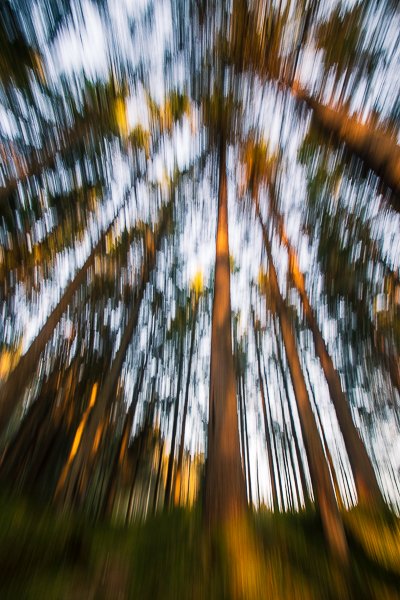Exploring ICM Photography: Techniques and Tips for Creating Artistic Images
Intentional Camera Movement (ICM) is a technique that allows photographers to create unique and artistic images by moving the camera during the exposure. In this article, I will explore the basics of ICM photography, including the equipment and techniques needed to get started. I'll also provide tips and examples to help you create beautiful and abstract images using this technique.
ICM photography is a technique that involves intentionally moving the camera during the exposure to create abstract and artistic images. This can be done by panning the camera horizontally, vertically, or diagonally, or by rotating the camera around its axis. The key is to move the camera in a smooth and controlled manner, while keeping the subject in focus.
Paning sideways as the waves crashed against the beach.photo by Are Ramstad
To get started with ICM photography, you will need a camera that allows you to control the shutter speed and aperture, to get the cleanest paning movement use a tripod. If you are hand holding I suggest putting your camera in burst mode, this will increase your chances of getting a photo you are happy with.
Paning upwards hand held with burst mode on, created a dreamy image of the trees.Photo by Are Ramstad
When setting the camera, you will want to choose a relatively slow shutter speed, usually between 1/15 and 1/4 of a second. This will allow you to capture the camera's movement during the exposure. As you advance and feel that you are confident in the technique, you can slow the shutter speed even further and experiment more. A 4-6 stop ND filter will help achieve a slow enough shutter speed during the day, so you can get those abstract images you have visualized. It's also essential to use a low ISO to reduce noise and a small aperture to keep the subject focused and reduce light to keep the shutter speed slow enough. Most of all, it's important to experiment until you find the settings that give you the desired result. ICM photography is about trying out different movements and settings and not being afraid to do things differently.
Planning sideways to create a painterly look for the photo.Photo by Are Ramstad
As I mentioned earlier, one of the most important things to keep in mind when using ICM photography is to practice and experiment. Try different shutter speeds, apertures, and movement directions to see what works best. It's also essential to have a good understanding of composition and to pay attention to the movement of the subject, different patterns and textures that you find interesting.
Photo: Are Ole Ramstad
4. subjects perfect for ICM
Landscapes: Landscapes can be transformed into dreamy and ethereal images by using ICM photography. The camera's movement can bring a sense of motion to the image, creating an abstract representation of the landscape. Experiment with different shutter speeds to create different effects - a slower speed will result in more dreamy, ethereal landscapes, while a faster speed will create more abstract, jagged patterns.
Water: Water is an ideal subject for ICM photography as the camera's movement can creatively capture the flow and movement of water. This can include capturing the waves of the ocean or the flow of a river. Capturing the movement of water with an ICM technique can result in stunning abstract patterns and shapes. Experiment with different shutter speeds to get different effects - a slower speed will result in smoother, dreamy water, while a faster speed will create a more choppy, textured look.
Architecture and cityscapes: ICM photography can create abstract images of buildings and structures. The camera's movement can create a sense of dynamism and highlight the lines and shapes of the architecture. Capturing the movement of cars, people, and buildings in a busy cityscape can produce exciting and abstract compositions. Experiment with different shutter speeds to get different effects - a slower speed will result in ghostly, blurred figures, while a faster speed will create more distinct, sharp lines.
Light trails: Light trails are another subject that can be captured creatively using ICM photography. The camera's movement can create a blur of light that captures the movement of vehicles or other sources of light. Experiment with different shutter speeds to create different effects - a slower speed will result in more flowing, abstract patterns, while a faster speed will create more distinct, sharp lines.
ICM photography is a technique that allows you to create unique and artistic images by intentionally moving the camera during the exposure. With the right equipment, techniques, and a bit of practice, you can create beautiful and abstract images that stand out from the crowd. If you got any thing to add to the article or if it helped you in any way, remember to let me know in the comment section. Thanks for reading and happy paning.
I hope that you found it informative and helpful. As someone who struggles with dyslexia, I want to let you know that I used a writing tool called OpenAI's GPT-3 to assist in the creation of this piece. GPT-3 has been an invaluable resource for me, helping me to fine-tune my writing and express my thoughts more clearly. While I was responsible for the overall direction and content of the post, GPT-3 helped me to refine the language and make the writing more cohesiv.










Thinking about the Sony ZV-E10 II? After six months of use, I took it on a weekend getaway to test its photo and video capabilities. In this hands-on review, I share what I love, what I don’t, and whether it’s worth buying. Read more for real-world insights, pros & cons, and sample images!